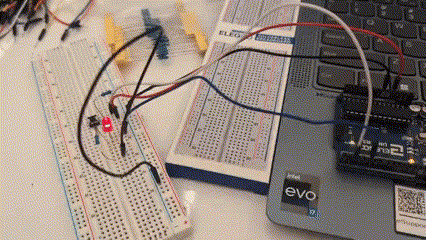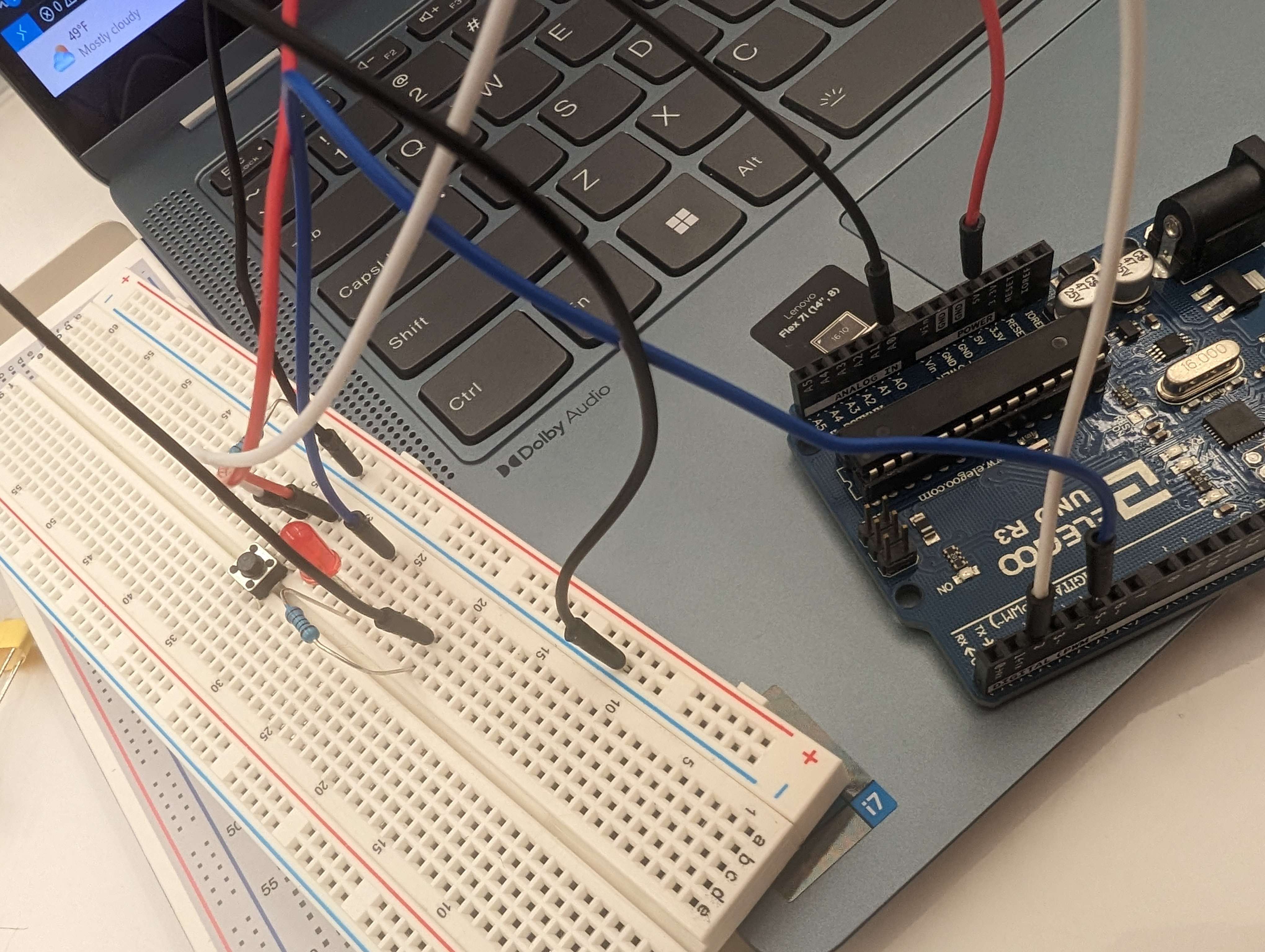 Here is all the documentation for assignment 6!
Here is all the documentation for assignment 6!
 Here is all the documentation for assignment 6!
Here is all the documentation for assignment 6!

Above is my circuit. when pressing the button, the screen turns from "not pressed" to "pressed!".
When typing into the keyboard, the light of the LED changes depending on the ASCII unicode of the key that is pressed.
In the video, I am pressing "0" and the spacebar, which doesn't change the light much, but it still changes.
Above is my schematic. I had to use a 10k resistor for the button and a 220 resistor for the red LED.
const int BUTTON_PIN = 2; // input pin from Arduino, yet to be set
const int LED_PIN = 5; //PWM pin from Arduino
void setup()
{
Serial.begin(9600); // begins serial
Serial.setTimeout(10); // sets maximum seconds for serial data
pinMode(BUTTON_PIN, INPUT); // sets the button as an input for the web
pinMode(LED_PIN, OUTPUT); // sets LED as an output from the web
}
void loop()
{
Serial.println(digitalRead(BUTTON_PIN));
delay(50);
if (Serial.available() > 0) { // if there's serial data
int inByte = Serial.read(); // read it
analogWrite(5, inByte); // use it to set the LED brightness
}
}
const BAUD_RATE = 9600; // This should match the baud rate in your Arduino sketch
let port, connectBtn; // Declare global variables
function setup() {
setupSerial(); // Run our serial setup function (below)
// Create a canvas that is the size of our browser window.
// windowWidth and windowHeight are p5 variables
createCanvas(windowWidth, windowHeight);
// p5 text settings. BOLD and CENTER are constants provided by p5.
// See the "Typography" section in the p5 reference: https://p5js.org/reference/
textFont("system-ui", 50);
textStyle(BOLD);
textAlign(CENTER, CENTER);
}
function draw() {
const portIsOpen = checkPort(); // Check whether the port is open (see checkPort function below)
if (!portIsOpen) return; // If the port is not open, exit the draw loop
let str = port.readUntil("\n"); // Read from the port until the newline
if (str.length == 0) return; // If we didn't read anything, return.
// trim the whitespace (the newline) and convert the string to a number
const buttonState = Number(str.trim());
// Change text and colors based on button state. In p5, you can set colors
// using standard CSS color names as well as many other color formats.
if (buttonState === 0) {
// If the button is not pressed
background("darkcyan"); // Background color
fill("coral"); // Fill color for the text
text("not pressed", windowWidth / 2, windowHeight / 2); // Position text in center of the screen
} else if (buttonState === 1) {
// If the button is pressed
background("lightskyblue"); // Background color
fill("yellow"); // Fill color for the text
text("pressed!", windowWidth / 2, windowHeight / 2); // Position text in center of the screen
}
}
// function to check key pressing
function keyPressed() {
console.log("writing key", key); // prints to console
port.write(key); // writes the key to the Arduino LED
}
// Three helper functions for managing the serial connection.
function setupSerial() {
port = createSerial();
// Check to see if there are any ports we have used previously
let usedPorts = usedSerialPorts();
if (usedPorts.length > 0) {
// If there are ports we've used, open the first one
port.open(usedPorts[0], BAUD_RATE);
}
// create a connect button
connectBtn = createButton("Connect to Arduino");
connectBtn.position(5, 5); // Position the button in the top left of the screen.
connectBtn.mouseClicked(onConnectButtonClicked); // When the button is clicked, run the onConnectButtonClicked function
}
function checkPort() {
if (!port.opened()) {
// If the port is not open, change button text
connectBtn.html("Connect to Arduino");
// Set background to gray
background("gray");
return false;
} else {
// Otherwise we are connected
connectBtn.html("Disconnect");
return true;
}
}
function onConnectButtonClicked() {
// When the connect button is clicked
if (!port.opened()) {
// If the port is not opened, we open it
port.open(BAUD_RATE);
} else {
// Otherwise, we close it!
port.close();
}
}